To the barrier, sir!
 Bashny.Net
Bashny.Net
That was a nice, noble,
Short call il cartel:
Courtesy, with clarity cold
I called a friend Lenski to a duel.
(Pushkin)
Dueling weapons, as it was? Until XIX, dueling, century and fights, and wars for thousands of years have used cold weapons. Education fencing was very popular in ancient India and ancient China, and in the Middle Ages, every free person in Europe has the right to bear arms.
text + 12 ph via leonsija
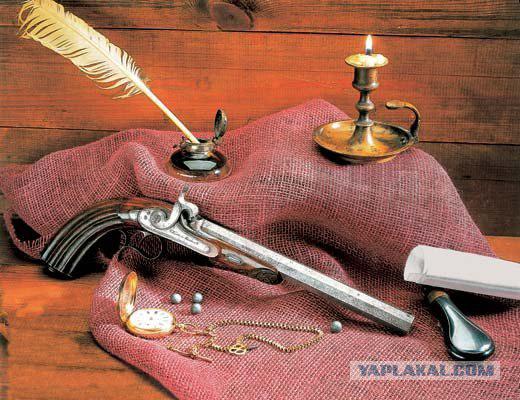
When, after the invention of gunpowder, armor became thicker and stronger, they began to reduce the severity of the sword: he becomes. Again, as in ancient Rome, there was a sword. Italian sword remained thin and narrow sword for injection. But this blade is easy to bend and break. And he began to make a triangular: the wounds inflicted by them, were very heavy.
___
Pirate Duel. Figure Howard Pyle.
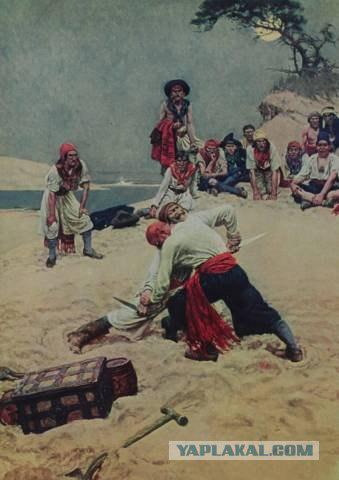
Since the end of the XV century. sword firmly in the arms of the Knights of Western Europe, and the fencing becomes art. There are books and tutorials for those who want to master this skill. The first guide to fencing was issued in 1474 by Jacques Pons and Peter Torres.
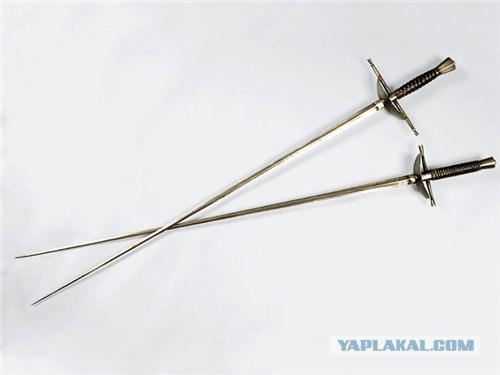
Initially, the fight with swords proceeded with panels of different shapes. They were small in size, and called brokeli. Moreover, these panels supplied with metal spikes like daggers. They were of different lengths, and they can be and to cut and chop. The very end of the sword XV-XVII centuries and also could chop and chop. In the XVI century. the shield being phased out and replaced it dagoy (a kind of dagger). In Spain, for the action of the left hand began to apply the coat (hence the expression "the knights of cloak and sword"). Its a wound on his hand and fought off their blows as a shield, or lash out at arms or the head of the enemy.
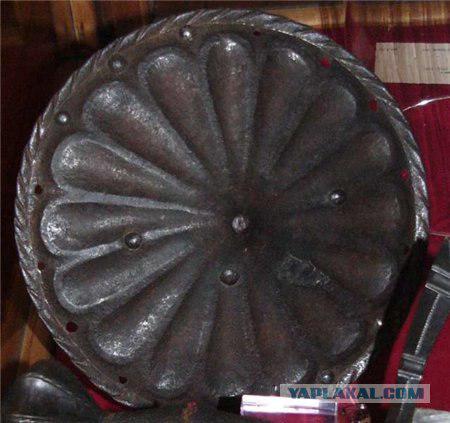
After the invention of the French rules of the duel she became a form of entertainment, and dueling fever in many European countries turned into an epidemic. In France, under Henry III (1519-1559) and Henry IV (1553-1610) dueling gambling sent to the light greater nobility than a decade of civil war. Terms and included fights between the seconds: the duel developed into real fights. Kings of the prison and threatened with death - nothing helped. The winner is the one who dies last.
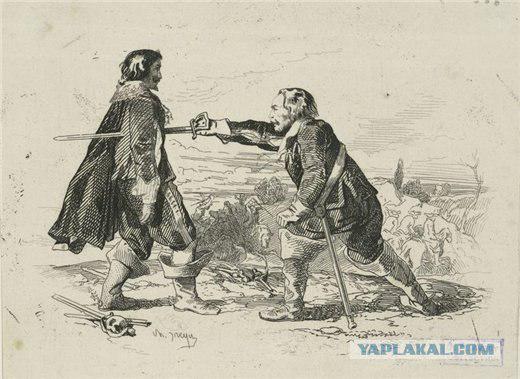
Unusual popularity of fencing and required a large number of teachers. Many teachers of fencing, as well as professional killers and duelists join unions. The first such corporation was "Fencing Federation of St. Mark" (1478 Frankfurt). In Spain there was "Fencing brotherhood" or "Bravo" - a caste of assassins and duelists.

In duels fought as infantry and cavalry swords and sabers. Such a fight usually ends with the death of one of the opponents, since the wounds inflicted by such weapons were very heavy.
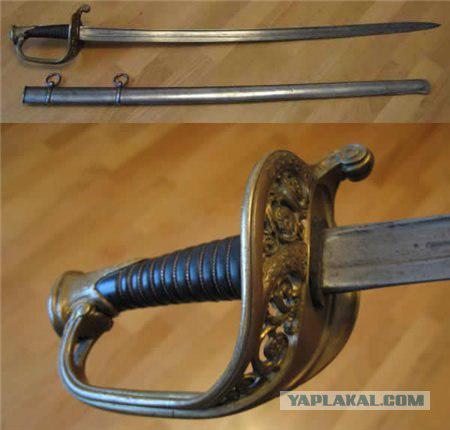
When it appeared the first fencing school in Russia? In his work at the behest of Peter I the book "Youth honest mirror or indication to worldly manners, collected from different authors" (1717), among other teachings there is "Mladen nobleman or gentleman, if learning his perfect, but chiefly in the languages, horse riding, dancing, epee in battle, and can inflict a good conversation, besides krasnoglagoliv and taught in books, can aforesaid such leisure, direct the court to be a man. " And learn epee nobleman was able to battle. In 1701 it was founded the school of mathematical and navigational sciences, in which the program in 1702 with the subject "rapier science" was a must (he practiced in schools up until the First World War). Was taught fencing and open in 1719 the Naval Academy of Sciences in St. Petersburg, and in the second half of the XVIII century. Fencing is introduced and some military academies. And women, too, are not inferior to men in this art.
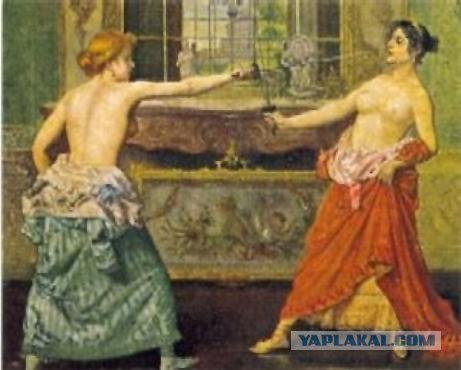
With the improvement of firearms spores settled with his help. Application guns removed the main problem of all duels - the age difference. They equalized the chances duelists different physical training. As for the small craftsmanship, it is difficult to find a military man does not have the hit the target from a distance of 10 steps (seven meters). Since the second half of the XVIII century pistol duel becomes predominant, especially since public opinion has always been on the side of dueling. By the end of this century finally formed the appearance of dueling pistols. First of all, it should be noted that the pair dueling pistols were absolutely identical and nothing from each other do not differ except for the numbers 1 or 2 on the trunk. Usually duelists did not get them familiar weapons were not allowed to even try lowering the quality of the outstanding pistol.
The exception was a duel because of the very heavy insults, but then the second party is also allowed to take their guns. During Pushkin's duel with Dantes both participants enjoyed another's arms. Pushkin fired pistols taken for him Danzas hire. Unfortunately, they have not survived. Dantes was given his second pistol d'Archiac, who borrowed it from his friend Baron Ernest de Barante. Currently, the pair of pistols kept in the museum of a small French town of Amboise. They were made Dresden gunsmith Karl Ulbrich, who is among the well-known masters.
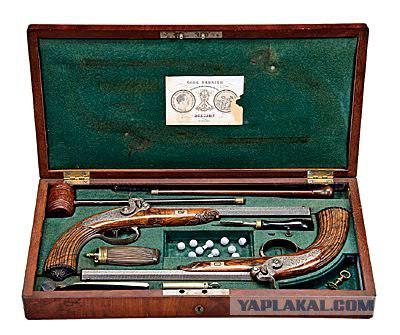
Under the rules of the duel, it was allowed to use as rifled and smoothbore guns, if only they were shooting at the same. Trigger gun could be softening device - Schneller, it's existed since the time of the invention of crossbows. However, oddly enough, many duelists preferred to guns with a rough descent. The reason is very simple: in a flurry of dueling unfamiliar with set trigger sensitive, could generate a random shot before the good aim. The ergonomics of the gun, the smooth running of parts of the castle was allowed to make a full accurate shot. It is known, for example, that Pushkin got into an ace card at a distance of 10 steps. The amount of gunpowder and bullet weight were sufficient to provide stopping power. The bullets were round lead with a diameter of 12-15 mm and weighing 10-12 grams. Gunpowder can put up to 3, 8 g.
In the 60 years of this century it is already an expert panel that has studied the circumstances of the death of Lermontov, has made control shots of dueling pistols. It turned out that their penetration is only slightly inferior to the TT pistol, the bullet that pierces through 8 pine boards at a distance of 25 meters. With such a high combat characteristics of dueling pistols and a small distance between the duelists left to wonder why they do not shoot each other. Explanation of this can be found in the features of a shot from the gun flint. Following the outbreak of the powder should pass on the shelf for about a second before you ignite the charge in the trunk and followed by a shot. Psychologically keep a gun in the right direction after the burning of the bare charge is extremely difficult, the hand moves involuntarily. In addition, the shelf cloud of smoke obscured the target and reaches into his eyes. Each country had its famous dueling masters for the production of weapons. In England, this Menton and Joseph Mortimer family, born in Germany Kyuhenreytorov from Regensburg, working in pistol practice for almost two centuries, France - Nicolas Bute and Henri Le Page. Last he was so famous in Russia, that his guns were considered synonymous with the dueling weapons. As you know, in "Eugene Onegin" describes the duel flintlock pistol and shot himself Pushkin himself already on the capsule.

Interestingly, that if in the second half of the XIX century, the number of duels in the Russian army apparently began to decline, after the official permission in 1894 their number increased sharply again.
By comparison, from 1876 to 1890 before the trial came only 14 cases of officers' duels (2 of these opponents were acquitted); from 1894 to 1910 it held 322 duels, of which 256 - of the courts of honor, 47 - with the permission of military chiefs and 19 unauthorized (to the criminal court has not reached any of them). It occurs annually from 4 to 33 fights in the army (on average - 20). According to the General Mikulin, from 1894 to 1910 in the officer duels participated as opponents: 4 general, 14 staff officers, 187 captains and staff-captains, 367 junior officers and 72 civilians. From 99 duels of insults 9 ended in severe outcome, 17 - and 73 with minor injuries - without bloodshed. From 183 duels for serious insult ended 21 severe outcome, 31 - with minor injuries and 131 - without bloodshed. Thus, the death of one of the opponents of any serious injuries ended yet a small number of poedinkov- 10-11% of the total. Of the 322 315 held dueling pistols and only 7 - with swords or sabers. Of these, 241 match (m. E. In 3/4 cases) were produced on a single pool, 49 - two, in the 12 - three in one - four and one - six bullets; distance ranged from 12 to 50 steps. Intervals between application of insults and fights ranged from one day to ... three years (!), But most of all - from two days to two and a half months (depending on the duration of the analysis of the case by the court of honor).
It accepts several types of pistol duels. Three of them were major: a duel with fixed arrow duel with "barriers" and the duel on parallel lines. In addition, there were fights with different conditions, which belonged shooting at a shorter distance, a gun duel, duels on rifles, carbines, revolvers, and finally an American duel. Duel is not always chosen arbitrarily, it kind of depended on the severity of the insult, what was three: simple insult inflicted on ordinary incivility; shameful insults and the most serious - assault. In a simple insult offended chose weapons at the infamous - and the kind of weapons duel, the last - the weapon, type of duel and the distance.
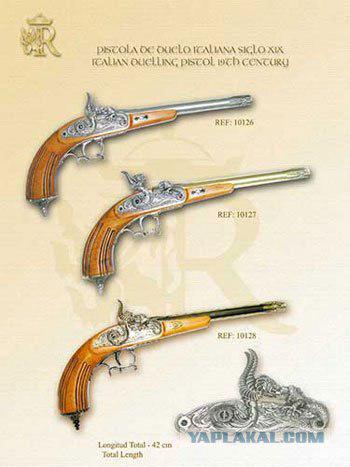
In the duel of the opponents could not talk to each other, clothes supposed to be dark, but the gate by the shirt - white. Both duelists had to empty his pockets, remove the studs and fasteners. About hats rules said nothing, but usually they were shot. Weapons obtained from opponents of the seconds on the safety notch. The duel began for the second's senior team with the words "Platoon" or "shoot", uttered an impartial voice. A feature of the fixed exchange duel was alternate shots in which the right of first determined by lot or severity of injury. Both the first and second shot were to follow each other no more than a minute, who provolynit - lose the right to a shot, but the period could be shorter by arrangement.
A variation of the match was a duel, in which arrows were back to back, and then turned the team, platoon hammers and shot in the prescribed manner. In these duels distance ranged from 15 to 35 steps, but the seconds to agree on anything less. For example, in 1802, a duel between Prince Shcherbatov and Josef von Saxon was held on 8 steps. Russian Prince fired the first shot and hit the chest of his opponent.
An interesting look so-called duel with "barriers". The distance is equal to 35-40 first steps. Before the two opponents at a distance of 10 paces from each pictured trait denoted cane or white flag. As a result, the final turned out 15-20 paces away. At the command "Forward" opponents platoon hammers and walked towards each other, holding a gun muzzle up. The velocity of the arbitrary, may stop without firing a shot. Start a fire could any duelist from any distance, but if one of them came to the barrier, the second stop, no one could force him to move on. The first shot is obliged to wait for a response shots for a minute, while his opponent can come right up to the barrier. The wounded man was given a shot at two minutes.
It was like a duel in parallel lines. Opponents of moving each of its boundaries, the distance between them was 15 steps. Before duel they were spaced apart by steps 25-30. In the process of moving the distance is reduced to a minimum, but everyone stayed on his line. The order of shooting arbitrary, speed and stop too.
Quite apart was an American duel. Sometimes the "American" was called not a duel, and drawing lots, after which vynuvshy black ball was obliged to shoot throughout the year. This American duel was a rather hunt, when the rivals went into the woods for a few days there and tracked each other, using all sorts of tricks, such as false fires, scarecrows and ambushes. Sometimes American duel looked like a normal fight with a gun or a knife, but was carried out without the seconds in front of the audience. A sort of democracy without a schematic view of "competition."
The most severe was a duel without witnesses in a locked room, as it is described by Mayne Reid in his novel "The Headless Horseman." However, the most sophisticated form of duel duel was called "cuckoo." This match was conducted in a completely darkened room, with a take off your shoes. One of the opponents shouted "cuckoo" and the other shot in the sound. The one who shouted, was obliged to remain in place. Then the roles are reversed, while one was killed there wounded.
Sporting duel with swords and sabers are gone, but the passion for the duel in the men's hearts indestructible. What kinds of duels invented! For example, during the War of American Independence, General Isaac Putnam got the call, but the duel with swords refused. He offered to put on a powder keg stearic candle and sit next to who first will hasten escape - a coward. The general sat down at the drums and began to smoke a cigar, but this time was the second enemy and apology said that he refuses to fight.
Another American general during the war in 1808 offered his opponent a walk along the city wall of the besieged city in the eyes of the enemy. Who killed - and he lost. They killed both. Again America, but the end of the XIX century. Someone Major Bright came to a duel not with a sword or a gun, but with a plate on which lay two green apples, one of which he offered to the enemy - at that time in those places was a cholera epidemic. The enemy hurried to give ...
Dueling Code
Duel can and should take place only between equals.
The basic principle and purpose of the duel - to solve misunderstandings between individual members of the general noble family among themselves, without outside help.
When you call a gentleman commoner first obliged to reject the call and give the latter the right to seek redress judicial procedure.
Between commoner duel is possible but is an anomaly, not answering their purpose.
Insult has encroachment on anyone's self-esteem, dignity and honor. It can be applied to the words and the action of writing.
According to the severity of abuse are three degrees of insult, or simply the first degree, a serious insult or second-degree assault and third-degree ...
Insults first degree: insults directed against pride, not affecting the honor, violation of courtesy, failure to comply with certain obligations with respect to persons, pursuant to which the latter is entitled to expect.
Insults second degree: insults against the honor or dignity of the person, defamation, offensive gestures, not passing to assault and battery.
Defamation has imputation known face of such an act, which is not permitted by the rules of honor, or is inconsistent with the dignity of the person.
The threat of strike action an insult - is also an insult to the second degree.
Assault and third-degree has really expressed the aggressive action of one person toward another.
At the touch of assault equivalent impact. The severity of the abuse does not depend on the force of impact. Wounding equals assault.
If the answer to the assault offended offender also cause offensive action, it does not be considered satisfaction and insulted still receive the first insult.
Circumstances change the severity of the offense depends from the person offended, on the personality of the offender, the method of application abuse. The severity of the insult to the woman rises by one degree.
When the husband of his wife's infidelity is considered an insult.
All insult named Rhoda are insults second degree.
All insult a woman is an insult of the first degree.
Harassment may be inflicted intentionally or unintentionally. In the latter case, the incident an apology should be considered closed.
Offended has a right to choose the kind of dueling weapons: swords, pistols or swords.
Source:
Short call il cartel:
Courtesy, with clarity cold
I called a friend Lenski to a duel.
(Pushkin)
Dueling weapons, as it was? Until XIX, dueling, century and fights, and wars for thousands of years have used cold weapons. Education fencing was very popular in ancient India and ancient China, and in the Middle Ages, every free person in Europe has the right to bear arms.
text + 12 ph via leonsija

When, after the invention of gunpowder, armor became thicker and stronger, they began to reduce the severity of the sword: he becomes. Again, as in ancient Rome, there was a sword. Italian sword remained thin and narrow sword for injection. But this blade is easy to bend and break. And he began to make a triangular: the wounds inflicted by them, were very heavy.
___
Pirate Duel. Figure Howard Pyle.

Since the end of the XV century. sword firmly in the arms of the Knights of Western Europe, and the fencing becomes art. There are books and tutorials for those who want to master this skill. The first guide to fencing was issued in 1474 by Jacques Pons and Peter Torres.

Initially, the fight with swords proceeded with panels of different shapes. They were small in size, and called brokeli. Moreover, these panels supplied with metal spikes like daggers. They were of different lengths, and they can be and to cut and chop. The very end of the sword XV-XVII centuries and also could chop and chop. In the XVI century. the shield being phased out and replaced it dagoy (a kind of dagger). In Spain, for the action of the left hand began to apply the coat (hence the expression "the knights of cloak and sword"). Its a wound on his hand and fought off their blows as a shield, or lash out at arms or the head of the enemy.

After the invention of the French rules of the duel she became a form of entertainment, and dueling fever in many European countries turned into an epidemic. In France, under Henry III (1519-1559) and Henry IV (1553-1610) dueling gambling sent to the light greater nobility than a decade of civil war. Terms and included fights between the seconds: the duel developed into real fights. Kings of the prison and threatened with death - nothing helped. The winner is the one who dies last.

Unusual popularity of fencing and required a large number of teachers. Many teachers of fencing, as well as professional killers and duelists join unions. The first such corporation was "Fencing Federation of St. Mark" (1478 Frankfurt). In Spain there was "Fencing brotherhood" or "Bravo" - a caste of assassins and duelists.

In duels fought as infantry and cavalry swords and sabers. Such a fight usually ends with the death of one of the opponents, since the wounds inflicted by such weapons were very heavy.

When it appeared the first fencing school in Russia? In his work at the behest of Peter I the book "Youth honest mirror or indication to worldly manners, collected from different authors" (1717), among other teachings there is "Mladen nobleman or gentleman, if learning his perfect, but chiefly in the languages, horse riding, dancing, epee in battle, and can inflict a good conversation, besides krasnoglagoliv and taught in books, can aforesaid such leisure, direct the court to be a man. " And learn epee nobleman was able to battle. In 1701 it was founded the school of mathematical and navigational sciences, in which the program in 1702 with the subject "rapier science" was a must (he practiced in schools up until the First World War). Was taught fencing and open in 1719 the Naval Academy of Sciences in St. Petersburg, and in the second half of the XVIII century. Fencing is introduced and some military academies. And women, too, are not inferior to men in this art.

With the improvement of firearms spores settled with his help. Application guns removed the main problem of all duels - the age difference. They equalized the chances duelists different physical training. As for the small craftsmanship, it is difficult to find a military man does not have the hit the target from a distance of 10 steps (seven meters). Since the second half of the XVIII century pistol duel becomes predominant, especially since public opinion has always been on the side of dueling. By the end of this century finally formed the appearance of dueling pistols. First of all, it should be noted that the pair dueling pistols were absolutely identical and nothing from each other do not differ except for the numbers 1 or 2 on the trunk. Usually duelists did not get them familiar weapons were not allowed to even try lowering the quality of the outstanding pistol.
The exception was a duel because of the very heavy insults, but then the second party is also allowed to take their guns. During Pushkin's duel with Dantes both participants enjoyed another's arms. Pushkin fired pistols taken for him Danzas hire. Unfortunately, they have not survived. Dantes was given his second pistol d'Archiac, who borrowed it from his friend Baron Ernest de Barante. Currently, the pair of pistols kept in the museum of a small French town of Amboise. They were made Dresden gunsmith Karl Ulbrich, who is among the well-known masters.

Under the rules of the duel, it was allowed to use as rifled and smoothbore guns, if only they were shooting at the same. Trigger gun could be softening device - Schneller, it's existed since the time of the invention of crossbows. However, oddly enough, many duelists preferred to guns with a rough descent. The reason is very simple: in a flurry of dueling unfamiliar with set trigger sensitive, could generate a random shot before the good aim. The ergonomics of the gun, the smooth running of parts of the castle was allowed to make a full accurate shot. It is known, for example, that Pushkin got into an ace card at a distance of 10 steps. The amount of gunpowder and bullet weight were sufficient to provide stopping power. The bullets were round lead with a diameter of 12-15 mm and weighing 10-12 grams. Gunpowder can put up to 3, 8 g.
In the 60 years of this century it is already an expert panel that has studied the circumstances of the death of Lermontov, has made control shots of dueling pistols. It turned out that their penetration is only slightly inferior to the TT pistol, the bullet that pierces through 8 pine boards at a distance of 25 meters. With such a high combat characteristics of dueling pistols and a small distance between the duelists left to wonder why they do not shoot each other. Explanation of this can be found in the features of a shot from the gun flint. Following the outbreak of the powder should pass on the shelf for about a second before you ignite the charge in the trunk and followed by a shot. Psychologically keep a gun in the right direction after the burning of the bare charge is extremely difficult, the hand moves involuntarily. In addition, the shelf cloud of smoke obscured the target and reaches into his eyes. Each country had its famous dueling masters for the production of weapons. In England, this Menton and Joseph Mortimer family, born in Germany Kyuhenreytorov from Regensburg, working in pistol practice for almost two centuries, France - Nicolas Bute and Henri Le Page. Last he was so famous in Russia, that his guns were considered synonymous with the dueling weapons. As you know, in "Eugene Onegin" describes the duel flintlock pistol and shot himself Pushkin himself already on the capsule.

Interestingly, that if in the second half of the XIX century, the number of duels in the Russian army apparently began to decline, after the official permission in 1894 their number increased sharply again.
By comparison, from 1876 to 1890 before the trial came only 14 cases of officers' duels (2 of these opponents were acquitted); from 1894 to 1910 it held 322 duels, of which 256 - of the courts of honor, 47 - with the permission of military chiefs and 19 unauthorized (to the criminal court has not reached any of them). It occurs annually from 4 to 33 fights in the army (on average - 20). According to the General Mikulin, from 1894 to 1910 in the officer duels participated as opponents: 4 general, 14 staff officers, 187 captains and staff-captains, 367 junior officers and 72 civilians. From 99 duels of insults 9 ended in severe outcome, 17 - and 73 with minor injuries - without bloodshed. From 183 duels for serious insult ended 21 severe outcome, 31 - with minor injuries and 131 - without bloodshed. Thus, the death of one of the opponents of any serious injuries ended yet a small number of poedinkov- 10-11% of the total. Of the 322 315 held dueling pistols and only 7 - with swords or sabers. Of these, 241 match (m. E. In 3/4 cases) were produced on a single pool, 49 - two, in the 12 - three in one - four and one - six bullets; distance ranged from 12 to 50 steps. Intervals between application of insults and fights ranged from one day to ... three years (!), But most of all - from two days to two and a half months (depending on the duration of the analysis of the case by the court of honor).
It accepts several types of pistol duels. Three of them were major: a duel with fixed arrow duel with "barriers" and the duel on parallel lines. In addition, there were fights with different conditions, which belonged shooting at a shorter distance, a gun duel, duels on rifles, carbines, revolvers, and finally an American duel. Duel is not always chosen arbitrarily, it kind of depended on the severity of the insult, what was three: simple insult inflicted on ordinary incivility; shameful insults and the most serious - assault. In a simple insult offended chose weapons at the infamous - and the kind of weapons duel, the last - the weapon, type of duel and the distance.

In the duel of the opponents could not talk to each other, clothes supposed to be dark, but the gate by the shirt - white. Both duelists had to empty his pockets, remove the studs and fasteners. About hats rules said nothing, but usually they were shot. Weapons obtained from opponents of the seconds on the safety notch. The duel began for the second's senior team with the words "Platoon" or "shoot", uttered an impartial voice. A feature of the fixed exchange duel was alternate shots in which the right of first determined by lot or severity of injury. Both the first and second shot were to follow each other no more than a minute, who provolynit - lose the right to a shot, but the period could be shorter by arrangement.
A variation of the match was a duel, in which arrows were back to back, and then turned the team, platoon hammers and shot in the prescribed manner. In these duels distance ranged from 15 to 35 steps, but the seconds to agree on anything less. For example, in 1802, a duel between Prince Shcherbatov and Josef von Saxon was held on 8 steps. Russian Prince fired the first shot and hit the chest of his opponent.
An interesting look so-called duel with "barriers". The distance is equal to 35-40 first steps. Before the two opponents at a distance of 10 paces from each pictured trait denoted cane or white flag. As a result, the final turned out 15-20 paces away. At the command "Forward" opponents platoon hammers and walked towards each other, holding a gun muzzle up. The velocity of the arbitrary, may stop without firing a shot. Start a fire could any duelist from any distance, but if one of them came to the barrier, the second stop, no one could force him to move on. The first shot is obliged to wait for a response shots for a minute, while his opponent can come right up to the barrier. The wounded man was given a shot at two minutes.
It was like a duel in parallel lines. Opponents of moving each of its boundaries, the distance between them was 15 steps. Before duel they were spaced apart by steps 25-30. In the process of moving the distance is reduced to a minimum, but everyone stayed on his line. The order of shooting arbitrary, speed and stop too.
Quite apart was an American duel. Sometimes the "American" was called not a duel, and drawing lots, after which vynuvshy black ball was obliged to shoot throughout the year. This American duel was a rather hunt, when the rivals went into the woods for a few days there and tracked each other, using all sorts of tricks, such as false fires, scarecrows and ambushes. Sometimes American duel looked like a normal fight with a gun or a knife, but was carried out without the seconds in front of the audience. A sort of democracy without a schematic view of "competition."
The most severe was a duel without witnesses in a locked room, as it is described by Mayne Reid in his novel "The Headless Horseman." However, the most sophisticated form of duel duel was called "cuckoo." This match was conducted in a completely darkened room, with a take off your shoes. One of the opponents shouted "cuckoo" and the other shot in the sound. The one who shouted, was obliged to remain in place. Then the roles are reversed, while one was killed there wounded.
Sporting duel with swords and sabers are gone, but the passion for the duel in the men's hearts indestructible. What kinds of duels invented! For example, during the War of American Independence, General Isaac Putnam got the call, but the duel with swords refused. He offered to put on a powder keg stearic candle and sit next to who first will hasten escape - a coward. The general sat down at the drums and began to smoke a cigar, but this time was the second enemy and apology said that he refuses to fight.
Another American general during the war in 1808 offered his opponent a walk along the city wall of the besieged city in the eyes of the enemy. Who killed - and he lost. They killed both. Again America, but the end of the XIX century. Someone Major Bright came to a duel not with a sword or a gun, but with a plate on which lay two green apples, one of which he offered to the enemy - at that time in those places was a cholera epidemic. The enemy hurried to give ...
Dueling Code
Duel can and should take place only between equals.
The basic principle and purpose of the duel - to solve misunderstandings between individual members of the general noble family among themselves, without outside help.
When you call a gentleman commoner first obliged to reject the call and give the latter the right to seek redress judicial procedure.
Between commoner duel is possible but is an anomaly, not answering their purpose.
Insult has encroachment on anyone's self-esteem, dignity and honor. It can be applied to the words and the action of writing.
According to the severity of abuse are three degrees of insult, or simply the first degree, a serious insult or second-degree assault and third-degree ...
Insults first degree: insults directed against pride, not affecting the honor, violation of courtesy, failure to comply with certain obligations with respect to persons, pursuant to which the latter is entitled to expect.
Insults second degree: insults against the honor or dignity of the person, defamation, offensive gestures, not passing to assault and battery.
Defamation has imputation known face of such an act, which is not permitted by the rules of honor, or is inconsistent with the dignity of the person.
The threat of strike action an insult - is also an insult to the second degree.
Assault and third-degree has really expressed the aggressive action of one person toward another.
At the touch of assault equivalent impact. The severity of the abuse does not depend on the force of impact. Wounding equals assault.
If the answer to the assault offended offender also cause offensive action, it does not be considered satisfaction and insulted still receive the first insult.
Circumstances change the severity of the offense depends from the person offended, on the personality of the offender, the method of application abuse. The severity of the insult to the woman rises by one degree.
When the husband of his wife's infidelity is considered an insult.
All insult named Rhoda are insults second degree.
All insult a woman is an insult of the first degree.
Harassment may be inflicted intentionally or unintentionally. In the latter case, the incident an apology should be considered closed.
Offended has a right to choose the kind of dueling weapons: swords, pistols or swords.
Source:
Tags
See also
The history of "Artek"
Accepted standard for integrated SIM-card
They no longer exist
Mobile cellular communications: how does it work?
The designer with higher education
The AEK-971 machine, use the "balanced system".
DISEASE - karmic causes and cure
Brain tricks
10 bugs that were the main "chip"
"Open the floodgates - wanted to ventilate"

















